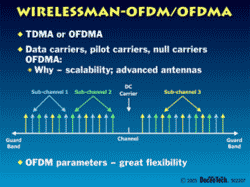|
WiMAX and 802.16: Broadband Wireless Access TM |
|

|
An advanced class
covering the 802.16 standard, and the WiMAX implementations that
are most relevant to your next design project
July 11-12
Austin, TX
Register for this Course |
|
Course
Description:
IEEE 802.16 is a standard for broadband wireless access
technology. The 802.16-based implementation named WiMAX (Worldwide
Interoperability for Microwave Access) is used for applications
that include "last mile" broadband connections, hotspot and
cellular backhaul, and high-speed enterprise connectivity for
businesses.
This course will provide the student with broad knowledge on
current WiMAX and 802.16 standards, trends, issues and
technologies. We have included content that is emerging from
recent IEEE 802.16 working group meetings and letter ballots.
These are the critical topics for todays development projects.
Course length:
2 days
Audience:
This course is designed for students who are working on WiMAX and
802.16 products and services, or expect to be working on those
projects soon. A student who is just beginning to work on
broadband wireless projects will gain a full understanding of the
entire set of 802.16 standards. Students who are working in WiMAX
will deepen their understanding of the latest standards issues,
and operations and management concerns.
|
|
This DoceoTech course was authored by Dr. Todor Cooklev. Dr.
Cooklev was chosen by the IEEE to write their definitive book that
covers all wireless standards, which is named Wireless
Communication Standards: A Study of IEEE 802.11, 802.15, 802.16.
|
|
Course Outline: |
|
v
Overview of Broadband Wireless Markets,
Applications, and Requirements
Architecture of a broadband wireless access network
Line of Sight vs Non-Line-of-Sight
Topologies and Mobility
Advanced Antenna Systems
Quality of Service
Single-Carrier and Multi-Carrier Options
The role of the WiMAX Forum
v
802.16 High-level Architecture
Physical Architecture
Protocol Architecture
Time Slots and Time Division Multiple Access
Uplink and Downlink Channel Descriptors and Maps
Physical Slots, Mini-Slots and Symbols
Time Division Duplex and Frequency Division Duplex
Options
Which Implementation Options are most common?
v
802.16 Medium Access Control
Steps for Joining an 802.16 network
Addressing and Encapsulation
Bandwidth Requests and Allocation
Automatic repeat request (ARQ)
Security
Quality of Service Scheduling Rules
MAC enhancements for advanced antennal systems
v
802.16 Physical Layer Options
Why are there so many PHY options?
Physical layer for 10 to 66 GHz
Single-carrier physical layer for operation between
2 and 11 GHz (802.16a)
Trellis-coded modulation
Multipath: Why multi-carrier approaches?
Orthogonal Frequency Division Multiplexing (OFDM)
Multi-carrier OFDM for 2-to-11 GHz Licensed
Operation
Multi-carrier OFDM for 2-to-11 GHz Unlicensed
Operation
Digital Signal Processing algorithms beyond the
standard
Orthogonal Frequency Division Multiplexing Access (OFDMA)
for licensed and unlicensed use
v
The Mobile future: 802.16e
Why a mobile version of 802.16?
802.16e adoption forecast
802.16e MAC and PHY enhancements
Handover
Cell Selection
v
Options for 802.16 Implementers
Advanced antenna systems
Coexistence problems and specifications
v
WiMAX Profiles
WiMAX Product Certification
WiMAX Forum is a trademark of the WiMAX Forum |
|